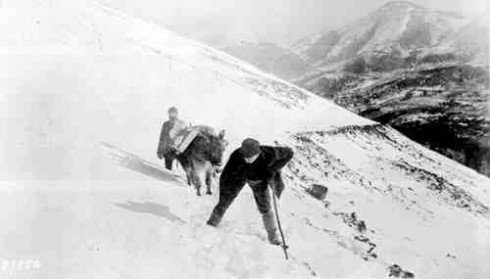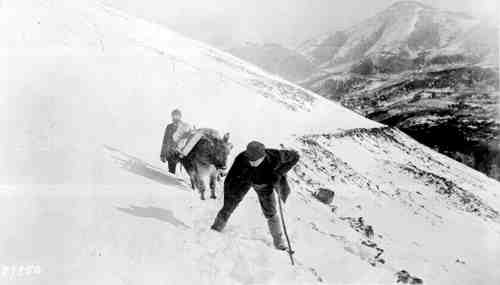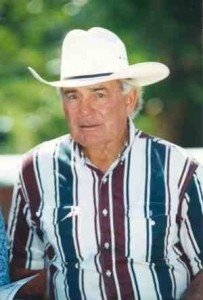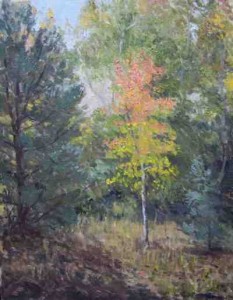Article by Central Staff
History – November 2006 – Colorado Central Magazine
WHEN WE LEFT ZEBULON PIKE at the end of October, 1806, he and 15 men were camped on the bank of the Arkansas River near present Kinsley, Kansas, between Dodge City and Great Bend. The days were growing colder and shorter, with ice in the river.
Pike’s party marched along the Arkansas through most of November. They saw and hunted “cabrie”– what we call antelope, but are technically pronghorns. The elk was then a plains animal, and Pike saw plenty of them, as well as buffalo and wild horses.
On Nov. 2, “we equipped six of our fleetest coursers with riders and ropes, to noose the wild horses,” but after two hours of chasing, “we could not take them.”
“I have since laughed at our folly; for taking wild horses in that manner is scarcely ever attempted, even with the fleetest horses and most expert ropers.”
Two days later, he “discovered the north side of the river to be covered with animals; which, when we came to them, proved to be buffalo cows and calves. I do not think it an exaggeration to say there were 3,000 in one view.” A couple of days later, Pike remarked that “their numbers exceeded imagination.”
On Nov. 7, they “killed three cow buffalo, one calf, two wolves, one brelaw.” What’s a brelaw? It wasn’t in any of our three unabridged dictionaries, nor in the editor’s notes of our two editions of Pike’s journal, but an Internet search found one reference, a scholarly article about the diets of trappers, which said a brelaw was a badger.
Then they once again encountered “the Spanish road” — a trail left a few months earlier by a Spanish force under Lt. Facundo Melgares, who had ventured from Santa Fé to Red Cloud, Nebraska, to maintain Indian alliances and deter the American expeditions of Pike and Lewis and Clark.
The hills along the river grew steeper. Two horses gave out; at first Pike took them along without loads, but then “was obliged to leave the two horses.”
Pike made a major decision on Nov. 11. “Finding the impossibility of completing the voyage [his orders were to ascend the Arkansas and descend the Red River] in the time proposed [that year], I determined to spare no pains to accomplish every object, even should it oblige me to spend another winter in the desert.”
On Nov. 12, 1806, Pike’s party entered Colorado. They were not the first Americans to visit what would become our rectangular state — trader James Purcell, to name one, had already been to the headwaters of the South Platte — but they were the first official expedition.

They encountered at least one Colorado resident on the 13th. “Discovered very fresh signs of Indians, and one of our hunters informed me he saw a man on horseback, ascending a ravine on our left. Discovered signs of war-parties ascending the river.” They augmented their buffalo diet that day with a turkey, “the first we have seen since we left the Pawnees.”
NEAR THE MOUTH of the Purgatory River on Nov. 15, “at two o’clock in the afternoon I thought I could distinguish a mountain to our right, which appeared like a small blue cloud; viewed it with the spy glass, and was still more confirmed in my conjecture, yet only communicated it to Dr. Robinson, who was in front with me; but in half an hour they appeared in full view before us. When our small party arrived on the hill they with one accord gave three cheers to the Mexican mountains. Their appearance can easily be guessed by those who have crossed the Alleghenies; but their sides were whiter, as if covered with snow, or a white stone. They appear to present a natural boundary between the province of Louisiana and New Mexico, and would be a definite and natural boundary.”
Pike must have worn his rose-colored glasses on Nov. 16: “The Arkansaw appeared at this place to be much more navigable than below, where we first struck it; and for any impediment I have yet discovered in the river, I would not hesitate to embark in February at its mouth and ascend to the Mexican mountains, with crafts properly constructed.”
HE ENCOUNTERED an optical phenomenon that many others have since experienced — the clear air and low humidity makes distant objects appear closer than they really are. On Nov. 17, they “pushed on with an idea of arriving at the mountains, but found at night no visible difference in their appearance from what we did yesterday.”
On Nov. 18, near La Junta, they laid over for two days to hunt buffalo and dry the meat, which they planned to carry with them since game might be scarce up ahead. Four days later, near present Boone just east of Pueblo, they met a party of Pawnee returning from an unsuccessful sally against the Comanche.
“I observed several running on the hill, as it were to surround us,” and “this caused a momentary halt,” but then “they met us with open arms, crowding round to touch and embrace us.”
All was not serene, though. “We found them to be sixty warriors, half with fire arms, and half with bows, arrows, and lances. Our party was 16 total.”
The peace pipes were set out, and Pike “ordered half a carrot of tobacco, one dozen knives, 60 fire steels, and 60 flints to be presented them. They demanded ammunition, corn, blanks, kettles, etc., all of which they were refused. The pipes yet lay unmoved, as if they were undetermined whether to treat us as friends or enemies; but after some time we were presented with a kettle of water, drank, smoked, and ate together.”
Tensions grew, though, and “We began to load our horses, when they encircled us and commenced stealing everything they could. I determined to protect ourselves, as far as was in my power, and the affair began to take a serious aspect. I ordered my men to take their arms and separate themselves from the savages; at the same time declaring to them that I would kill the first man who touched our baggage.”
The Pawnee walked away, and Pike’s party marched off. He found that they had taken a sword, broad-axe, and other small articles. “I felt myself sincerely mortified, that the smallness of my number obliged me thus to submit to the insults of lawless banditti.”
ON THE OTHER HAND, Pike avoided a battle in which he and his command almost certainly would have been wiped out, and he avoided the dubious distinction of being the first American soldier to battle Indians in Colorado.
Pike’s most famous non-accomplishment started the next day, on Nov. 23. They had reached modern Pueblo, where Fountain Creek joins the Arkansas. “As the river appeared to be dividing itself into many small branches, and of course must be near its extreme source, I concluded to put the party in a defensible situation, and ascend the north fork [Fountain Creek] to the high point [Pike’s Peak] of the blue mountain [Front Range], which we conceived would be one day’s march, in order to be enabled, from its pinical, to lay down the various branches and positions of the country.”
NOT A BAD IDEA — some aerial reconnaissance, as it were. To secure the camp, Pike’s men “cut down 14 logs, and put up a breast work, five feet high on three sides and the other was thrown on the river.” That was very likely the first structure built by Americans in Colorado. Nothing is left of it today, of course — the Long expedition of 1820 could find no trace even then.
Pike, along with Dr. Robinson and Privates Theodore Miller and John Brown, headed for the mountain at 1 p.m. on Nov. 24, “with an idea of arriving at the foot of the mountain, but found ourselves obliged to take up our night’s lodging under a single cedar which we found in the prairie, without water and extremely cold.”
He hoped to reach the summit on the 25th, “but was only able to encamp at its base, after passing over many small hills covered with cedars and pitch-pines.” What Pike called cedars were really junipers; just why people insist on calling them cedars is a mystery, but it’s obviously gone on for a long time.
The next day, he expected “to return to our camp the same evening” after climbing the mountain, so “we left all our blankets and provisions.” They “killed a deer of a new species,” which was our familiar mule deer, so named on account of its long ears.
When they awoke the next day, they were “hungry, dry, and extremely sore, from the inequality of the rocks on which we had lain all night,” a complaint that would be echoed by generations of Colorado campers afterwards.
They climbed to a sub-peak (perhaps Cheyenne Mountain; the precise route has provided much scholarly speculation), where “we found the snow middle deep; no sign of beast or bird inhabiting this region. The thermometer, which stood at 9° above zero at the foot of the mountain, here fell to 4° below zero.
“The summit of the Grand Peak, which was entirely bare of vegetation and covered with snow, now appeared at the distance of 15 or 16 miles from us. It was as high again as what we had ascended, and it would have taken a whole day’s march to arrive at its base, when I believe no human being could have ascended to its pinical. This, with the condition of my soldiers, who had only light overalls on, no stockings, and were in every way ill provided to endure the inclemency of the region; the bad prospect of killing anything to subsist on, with the further detention of two or three days which it must occasion, determined us to return.”
Thus Pike turned back without climbing Pike’s Peak. They reached the Pueblo camp on Nov. 29. On the last day of the month, “it snowed very fast, but my impatience to be moving would not permit my lying still at that camp.” They passed the remains of several Comanche camps, and stopped for the night after traveling 15 miles.
AND NOW, for the Pike Bicentennial of November, 2006:
November 4: “How did Pike’s Peak become so famous?” A free public lecture at 2 p.m. about “marketing the mountain” at the Colorado Springs Pioneer Museum by Leah Davis Witherow, museum archivist. This illustrated presentation will show how public perceptions of Pike’s Peak have changed over time, and how community boosters have used the mountain to draw visitors. The program is free, but reservations are encouraged at 719-385-5990.
November 13: Pike Slept Here and Rededication of Pike’s Tower in Willow Creek Park in Lamar. The public is invited to meet at Pike’s Tower at 5 p.m. for a rededication ceremony of a limestone monument to Pike set on or near the very spot he and his men camped in Lamar on November 13, 1806.
After the ceremony, the public is invited to a presentation of Pike’s expedition by historian and Pike re-enactor Don Headlee at the Lamar Public Library at the corner of Parmenter and Main. Refreshments will be provided by The Lamar Friends of the Library and original pen and ink drawings of Pike’s expedition by Salida artist Jon McManus will be on display.
For information, contact the library at 719-336-4632 or Kathy Wootten of the Friends of the Lamar Library at 719-336-7634.
November 15: This will be the historical dedication of the marker commemorating the “First Sighting” of the mountain to later be named after Zebulon Pike. At John Martin Reservoir, east of Las Animas. Call 719-336-3476.
November 18: Rock Ledge Ranch near Colorado Springs will offer living history demonstrations and talks about the Pike expedition. For more information, call 719-385-5631.
November 20: Woodruff Memorial Library, La Junta. Illustrations from Dr. Jack Cooper’s new edition of Pike’s Journal will be on display until the end of November.
November 24: The Salida Parade of Lights, starting downtown after sundown, will have a Pike theme.



